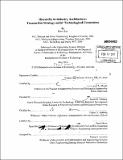Hierarchy in industry architecture : transaction strategy under technological constraints
Author(s)
Luo, Jianxi
DownloadFull printable version (13.59Mb)
Other Contributors
Massachusetts Institute of Technology. Engineering Systems Division.
Advisor
Christopher L. Magee.
Terms of use
Metadata
Show full item recordAbstract
Motivation -- Industrial firms survive, sustain and co-evolve by participating in the sector of innovation and production through industrial transactions with each other. However, it is difficult for specialized firms to be aware of and manage accordingly the kind of systemic constraints and opportunities induced by relevant but indirect transactions, as well as the technological and economic requirements of their value chains, which they cannot control or even sufficiently observe. The myopia may cause specialized firms to implement incorrect strategies, leave them vulnerable to system failures or ignorant of emerging opportunities. This implies a paradox: the simultaneous needs to specialize and to understand and manage the big picture of the eco-system. Goal -- Previous industry studies have focused on the question if a transaction with an external firm is needed rather than in-house production, and on empirical work from single industries or bilateral relationships between firms. Meanwhile, the firms' positions in the sectoral transactional network are also influential to the success and performance of firms. In this dissertation, I conduct transactional network analysis to explore how firms are organized in the sector of aggregated industries, in order to shed light on the set of previously ignored knowledge on industrial transactions, which is valuable to single firms in designing strategies and managing operations but is not available from firm- and industry-level analysis. Hierarchy in Industry Architecture -- At the sector level, existing theories often assumed hierarchical or non-hierarchical relationships among industrial firms, and quantitative evidence on variable degrees of hierarchy in industry sectors is lacking. This dissertation first identifies and defines the type of hierarchy relevant to industry studies -flow hierarchy, develops a network-based metric on the degree of hierarchy (one-way flow of transactions), and applies it to the transaction data from two industrial sectors in Japan. The empirical results show that the electronics sector exhibits a significantly lower degree of hierarchy than the automotive sector due to the presence of many transaction cycles. It shows that the simplistic hierarchy hypothesis for production sectors does not always hold. Industrial Network Model and Transaction Specificity -- I further create a network simulation model with random networks to relate sector-level hierarchy degrees to firm-level behavioral variables, and infer transaction specificity, i.e. the extent to which a firm is captive to a niche of customers positioned closely in the industrial network hierarchy. The model builds on three basic rules on market structures, i.e. hierarchy, niche, and the mapping relationship between roles and positions. Transaction specificity provides a way to quantify the tendency of a firm to fix or institutionalize its role according to its relative network position, or where the transactions of a firm are oriented in the value chains, whereas traditional studies analyze whether a transaction versus in-house production is needed. The result shows that transaction specificity in the electronics sector is quantitatively much lower than that in the automotive sector. Interviews and Firm Boundary Strategies -- I further conducted interviews with nine firms in the two sectors and found that, with decision rationales related to product modularity, innovation dynamics and asset specificity, the major electronics firms take the permeable vertical boundary strategy and diversified horizontal boundary strategy, which decrease transaction specificity so that many transaction cycles emerge in the electronics sector. My analysis shows the permeability of a firm's vertical boundary, i.e. playing multiple value chain roles, is the necessary condition for transaction cycles to emerge. Meanwhile, these two strategies are not feasible in the automotive sector according to interviews. They are also not observed in the American electronics sector. My data show the American electronics firms tend to be vertically specialized in the value chains. Social-Technical Arguments -- Linking network analysis results, interview data, and the prior work on the physical limits to product modularity, I argue that higher power level of a sector's technologies leads to higher transaction specificity, and more hierarchical transaction lows across the sector. High power technologies constrain strategic transaction choices, while lower power technologies enable a larger option space of transaction strategies, for companies to explore and exploit. Implications -- For academics, the use of network analysis permits transaction cost analysis, or more general analysis of transaction-related decisions, to be extended from the boundary of a firm to the architecture of a sector comprising related industries. It gives us a bird's-eye view to observe firm-level transaction behaviors and create new knowledge on transaction specificity. In addition, the analysis of the physical properties of product technologies allows us to interpret the difference in transaction specificities and hierarchy degrees of different sectors, which economic and sociology theories cannot explain. For industry practitioners, this research suggests that firms' choices for industrial transactions are under some predictable constraints from product technologies. A better understanding of the linkages between industry architecture, firm transaction strategy, and product technology, in turn can guide companies to tailor transaction strategies to implicit technological constraints and to adequately explore strategic options made feasible by technologies.
Description
Thesis (Ph. D.)--Massachusetts Institute of Technology, Engineering Systems Division, 2010. Cataloged from PDF version of thesis. Includes bibliographical references (p. 154-163).
Date issued
2010Department
Massachusetts Institute of Technology. Engineering Systems DivisionPublisher
Massachusetts Institute of Technology
Keywords
Engineering Systems Division.